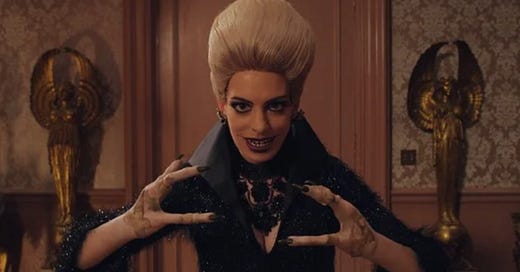For someone who doesn’t often write about disability, I’ve done an awful lot of it over the past year or so, even and especially right here in this newsletter. I won’t bore you with the details of my particular deal (I’ve already written about it before) but suffice it to say, I’m a bit atypical, and seldom see my specific disability reflected in mainstream disability discourse, let alone on stage or screen. And in the odd case when I do, it tends to be… unflattering, shall we say.
As I was mindlessly scrolling Twitter last night, I spotted a new hashtag - #NotAWitch - that looked like fun. Upon further inspection, though, it became apparent that this was in fact no fun at all, and was rather a reaction to the latest cinematic upgrade of beloved childrens author and noted racist Roald Dahl’s The Witches, which stars Anne Hathaway as the leader of a gang of fancy witches who hate children. The outcry wasn’t about Dahl himself, or Hathaway’s performance; rather, it was over certain stylistic liberties that had been taken with the witches’ costuming and design. Simply put, these objectively evil creatures were all given three fingers and no toes, and looks like an exaggerated version of what people like me who have syndactyly or ectrodacytyly sport in real life. Those in the limb difference community (which is small but vocal - we are rare!) were upset over seeing such a negative portrayal, and concerned about the message it may send to little kids who are made different.
The hashtag #NotAWitch was created as a response, and is populated by people proudly showing off their limbs or lack thereof. It is very sweet and empowering and made me tear up a little bit (I’m not the most touchy-feely type, but it’s hard being the only person you know who looks the way you do, especially when you’re young). The predictable backlash came from both general dickheads who couldn’t grasp the idea that some disabled people may not enjoy being painted as literal baby-killing monsters in a major motion picture, and from witches themselves, who objected to both the film’s nasty portrayal of witchcraft and the limb difference advocates’ desire to distance themselves from witches, which they saw as perpetuating its own negative stereotypes. Hathaway has already apologized for the potential harm she and the other characters have caused, and plugged the Lucky Fin Project, a Detroit-based nonprofit.
I understand why witches would be upset, but will say that you can hide your religious and spiritual beliefs, but you can only hide your hands for so long before someone notices something’s off. Really, this should be a moment of solidarity between the limb difference world and broader disability community and witches; all of us have been persecuted throughout the ages, and have been lumped together more often than not. How many neurodivergent people have been labeled “crazy” and confined to institutions (or burned at the stake) because they failed to conform to societal expectations? How many disabled children have been branded “monsters” and been mistreated, abused, and kept hidden away? The very word teratology—which encompasses the study of abnormalities of physiological development such as congenital deformities—stems from the Greek word for monster.
I am still thinking through my feelings on all of this as someone who’s both meandering through life with less than the standard set of fingers and close with many people who are disabled, neurodivergent, witches, or some intersection thereof. My gut feeling is that we need to stick together, because under a Christo-fascist government that sees people with disabilities as an expendable afterthought and religious minorities as a threat, the communities we’ve built are all we’ve got. We may be monsters, but we matter, too.



